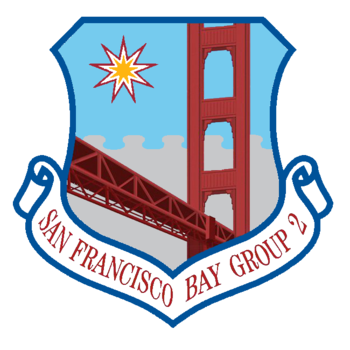History of Group 2
History of Group 2
Immediately following the attack on Pearl Harbor and the entrance of the U.S. into World War II, the first wings and groups of the Civil Air Patrol were formed nation-wide.1 In Northern California, Leonard B. Daniels assumed command of the nine counties of San Francisco Bay Area.2
By 1944, there were enough squadrons in the San Francisco Bay Area to justify the creation of separate groups. The first two groups in the Bay Area were the Second Group located on the Peninsula and the Fourth Group located in the East Bay. Second Group was under the command of Captain Thomas Fair Neblett,2 and the Fourth Group was under the command of Captain Ray P. Bowman.3
In December of 1945, Captain Neblett assumed a staff position at the California Wing Headquarters and command of Second Group was transferred to Captain Victor Rubon.4
In 1947, Captain Rubon turned over command to Major Edmund C. Fey.
In January 1949, Second Group was renamed Group 2 and this was reflected in the first CAWG Unit Locator.5 Major Fey would serve as the Group 2 Commander into the 1950’s.
In 1953, Major Frank P. Amo was in command and would serve in the role until 1957.
In 1955, Group 2's name was changed to Peninsula Group 2. 6
This name would remain until 1983 when the group was consolidated with others to form the current San Francisco Bay Group 2.7
[1] "Calls Issued for Fliers to Form Patrol," Oakland Tribune, January 23, 1942.
[2] "Glider Club is Proposed Here," Oakland Tribune, February 01, 1942.
[3] "WLB’s Neblett to Aid Bay Air Group," San Francisco Examiner, June 05, 1945.
[4] "CAP Bay Area Wing Formed," San Mateo Times, December 31, 1945.
[5] "California Wing Locator – January 1949," California Wing Civil Air Patrol, January 1949.
[6] "Belmont Boat Station for Civil Air Patrol," San Mateo Times, December 27, 1955.
[7] Civil Air Patrol. California Wing. Bear Facts, Fall, 1983.
Commanders of Group 2
| Group Commander | Dates of command |
| San Francisco Bay Group 2 | |
| Maj Richard West (incumbent) | 21 Oct 23 |
| Lt Col Shawn Lawson | 2021-2023 |
| Lt Col Noel Luneau | 2018-2021 |
| Lt Col Brett Dolnick | 2014-2018 |
| Maj Stephen Renwick | 2011-2014 |
| Maj Kevin McDowell | 2008-2011 |
| Lt Col Mitch Richman | 2004-2008 |
| Lt Col Kenneth W. Parris | 2001-2004 |
| Maj Paul Groff | 1998-2001 |
| Maj William Brew | 1995-1998 |
| Maj Garry L. Krum | 1992-1995 |
| Lt Col Paul C. Zimmerman | 1987-1992 |
| Maj Frederick Nelson | 1985-1987 |
| Peninsula Group 2 | |
| Lt Col James M. Howell, Jr. | 1983-1985 |
| Lt Col Steven Updike | 1979-1983 |
| Lt Col V. Lee White | 1977-1979 |
| Maj Donald Towse | 1971-1975 |
| Unknown | 1957-1971 |
| Group 2 | |
| Maj Frank P. Amo | 1953-1957 |
| Unknown | 1950-1953 |
| Maj Edmund C. Fey | 1947-1950 |
| Second Group | |
| Capt Victor Rubon | 1946-1947 |
| Capt Thomas Fair Neblett | 1944-1945 |
Emblem of Group 2
Group 2’s emblem was designed in 2008 by then-Deputy Commander Michael S. “Monty” Montgomery. Its symbolism is explained by former Group 2 (and California Wing) commander Ch (Col) Kenneth W. Parris:
The central feature of the shield is the south tower of the Golden Gate Bridge. The bridge signifies the group is geographically centered around the San Francisco Bay, from which the group derives its name. The south tower is above Fort Point, which defended the mouth of the San Francisco Bay from 1853 to 1970. It represents CAP’s early role in defending the homeland during World War II. The Golden Gate Bridge also has two towers and each tower had two vertical supports, symbolic of the two categories of members in our organization: senior members and cadets and of the group’s number, 2. The bridge tower also has three connecting cross-pieces, symbolic of the three primary missions of CAP that joins together senior members and cadets in a common purpose.
The nebuly line of partition on the shield is similar to that on the coat of arms of the US Air Force, CAP’s parent organization. In heraldry, the nebuly symbolizes clouds. The blue on the top half of the shield represents both blue skies and the Air Force Blue of the US Army Air Corps, Civil Air Patrol, and US Air Force. The grey of the lower half represents the fog that is prevalent in the San Francisco Bay Area.
The blue and silver grey joined together in the nebuly partition also represent the epaulets of the US Air Force officer above linked with the silver grey epaulets of the Civil Air Patrol officer below, symbolizing the group is part of an organization that has joined together in mission and purpose for the benefit of the whole of the American people.
The Golden 9-pointed Star in the upper left of the shield represents the “Golden Gate”, which is the opening to the San Francisco Bay from the Pacific Ocean. The nine rays of the sun represent the nine squadrons that comprised Group 2 when the patch was adopted. From the attached Request for Group Insignia Approval dated 21 March 2008: "This insignia’s star may either remain at 9 points – with respect to the insignia’s historical “original” squadron tally – or flex to reflect a current number of squadrons, per the group commander’s approval. All versions, however, could be honored indefinitely, so as to alleviate financial burdens associated with the recreation of new insignia."










